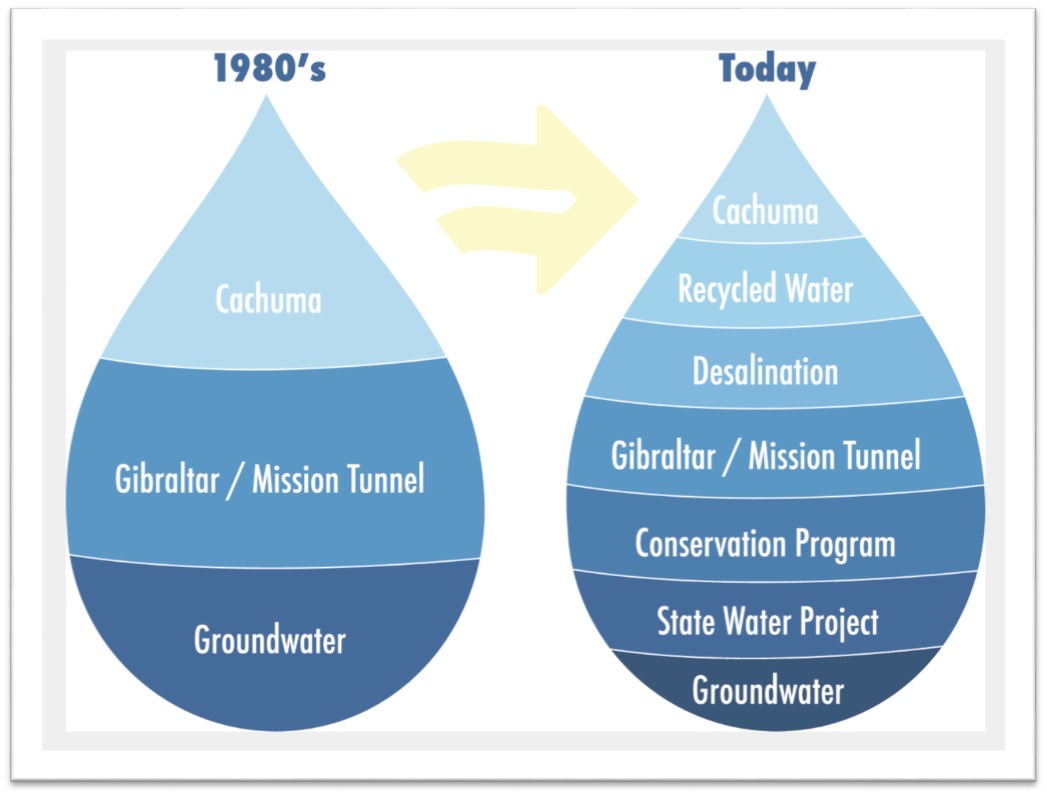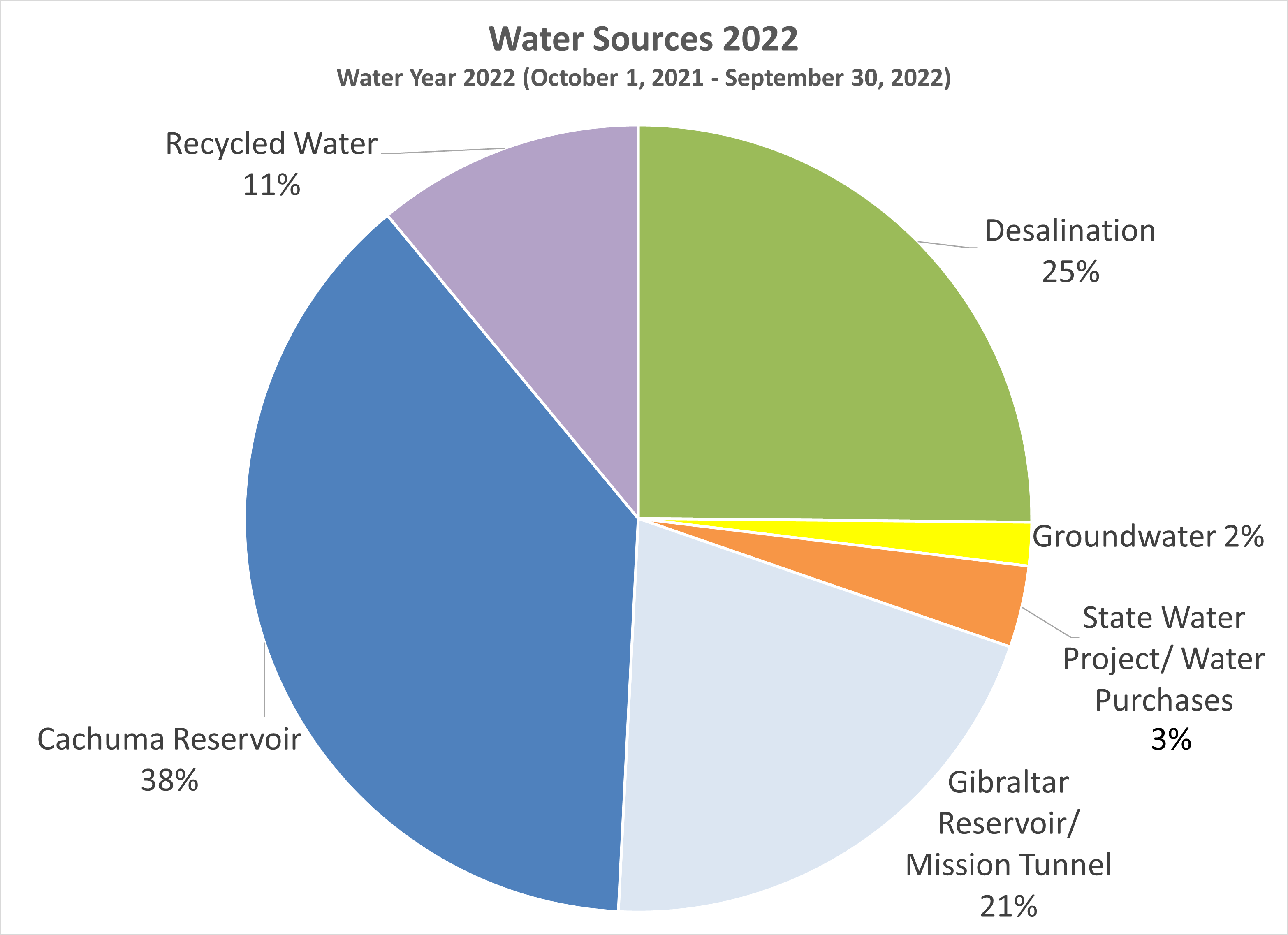Drought Information
The above average rainfall of 2023 and 2024 has improved Santa Barbara’s water supply outlook, and the City has enough water to meet anticipated demands for at least the next three years. On June 13, 2023 the Santa Barbara City Council repealed the Stage Two Water Shortage Alert in response to the City’s change in water supply outlook. However, given that water conservation is a way of life in Santa Barbara and the next drought may be right around the corner, we can all continue to make a difference by being efficient with our water use.
Current Water Use Regulations
To promote the efficient use of water, certain water regulations are in place at all times, even when the City is not in a drought. Current water usage regulations are:
- Any water use that causes significant runoff beyond the boundaries of a property is prohibited.
- All leaks must be repaired within 72 hours after notice by the City.
- Irrigation during and within 48 hours after measurable rainfall is prohibited. Measurable rainfall is defined as .25 inches or more during a 24-hour period measured here.
Diverse Water Sources
To ensure reliable water supply even during drought, the City maintains a diverse water supply portfolio. Learn more about the City’s water sources here.


Drought FAQs
No. The above average rainfall of winter and spring 2023 has dramatically changed Santa Barbara’s water supply outlook, and the City has enough water to meet anticipated demands for at least the next three years.
However, given that water conservation is a way of life in Santa Barbara and water remains an important shared resource, we can all continue to make a difference by being efficient with our water use.
Yes, these City regulations are:
- Any use that causes significant runoff beyond the boundaries of a property is prohibited.
- All leaks must be repaired within 72 hours after notice by the City.
- Irrigation during and within 48 hours after measurable rainfall is prohibited. Measurable rainfall is defined as .25 inches or more during a 24 hour period, measured here.
Residential lawn watering is not impacted by the statewide ban on watering non-functional turfgrass. For commercial, institutional, and industrial lawns, there is a statewide ban on potable irrigation of non-functional turfgrass. Non-functional turfgrass is defined as turfgrass that is solely ornamental and not regularly used for human recreational purposes or for civic or community events.State Board FAQs
No, City customers are not restricted from watering on certain days. Other water agencies may have watering day restrictions. If your water provider is not the City of Santa Barbara, please consult with them regarding their adopted restrictions.
Visit SantaBarbaraCA.gov/ReportWater to fill out our online reporting form. Provide as much detail as possible, including the location, time of day, and pictures. Once we have the information, we will send staff out to inspect and follow up.
No, our enforcement actions are complaint-driven and we rely on our community to help keep an eye out and report to us.
Yes, we encourage using a bucket and sponge and limiting the use of running water. Use a shut-off nozzle on your hose, or take cars to a local car wash, since they recycle their water.
At this time, there is no restriction on permitting new pools. New pools will need to adhere to the pool cover requirement as part of permitting.
For specific tree watering information, signs of drought stress in trees, FAQs, and more, click here.
The desalination facility provides about 30 percent of Santa Barbara’s water supply. The desal plant is one part of the City’s diverse water supply portfolio, which includes surface water from Cachuma and Gibraltar reservoirs, groundwater, State water, purchased water, recycled water, and conservation. Learn more about the desal plant here.
As Santa Barbara has developed over the decades, the water use associated with development projects represents a small portion of overall water use. In fact, Santa Barbara’s water use today is the same as it was in the 1950s, despite population doubling since that time. There are several reasons for development having a minimal impact on Citywide water use, including:
- Most development will be multi-unit development such as apartments, which have a relatively low per-person water use.
- New development is built to the latest efficiency standards for landscaping and plumbing fixtures, making it more water efficient than older developments.
- Since there are very few vacant parcels in the City, much of the water use for new projects is offset by water use of the previous development.
Analysis of water demand through 2050 from anticipated residential growth shows that this growth is expected to have a minimal impact on water demand long term. The Water Resources Division works closely with the Community Development Department to ensure our planning is aligned. The City’s Enhanced Urban Water Management Plan includes projected water demand from development anticipated under the City’s General Plan.
Pre-drought, the average single family residence used approximately 13 hundred cubic feet (HCF) per month (9,700 gallons). Currently, average single family residence usage is 9 HCF per month. In multi-unit residential buildings, the average usage pre-drought was approximately 5 HCF (3,700 gallons) per month per dwelling unit. Currently, average multi-unit usage is 4 HCF per month per dwelling unit. Learn more about historical water usage.
